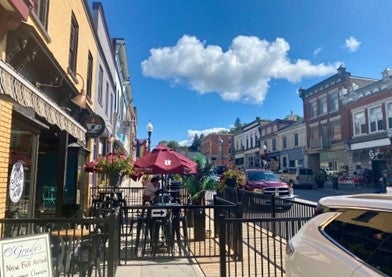The immediate benefit of Heritage Conservation District (HCD) designation is a planning process that respects a community’s history and identity. District designation is one of the best ways to ensure that this identity is conserved. The adoption of a HCD plan as part of the designation process ensures that the community’s heritage conservation objectives and stewardship will be respected during the decision-making process.1
Bill 23 left HCD designation in Ontario untouched. Except for two changes: (a) new rules about the application of criteria for cultural heritage value to district designations; and (b) new rules for amending and repealing heritage conservation district plans.
These rules would be found not in the OHA itself but in regulations under the Act.
With respect to (a), the application of criteria, the rules came into force for new HCDs on January 1 of this year via changes to O. Reg. 9/06.
With respect to (b), the rules for amending and repealing districts, these are not in place. They are presently “under development” by the Ministry of Citizenship and Multiculturalism, which has committed to consulting on the new rules this fall.2

Queen Street, the spine of St. Marys’ Heritage Conservation District.
Let’s look more closely at these changes. Today we’ll start with (b) and the question of amending and repealing HCDs.
The sweeping changes to the OHA in 2005 included major changes to district designation. Part V was amended to, among other things, introduce a requirement for new districts to have a HCD plan — until then a plan was considered a best practice and was not obligatory. The Act set out in detail the required contents of the plan as well as the process, including public engagement, to be followed to put one in place.
A HCD plan adopted in this way has considerable clout. Unlike old plans adopted previously (pre-2005), whose policies and guidelines are advisory only, the new plans included mandatory policies and guidelines that even, in the event of a conflict, would take precedence over other municipal by-laws including zoning by-laws. With such robust plans district designation became a much stronger planning mechanism for recognizing and conserving an area’s heritage character and managing its changes and development.
In the run-up to the 2005 changes — and after! — there was understandable concern about what would happen to existing district designations and their “old” plans. As with Part IV designations, the 2005 changes left district designations in place while strengthening their demolition controls through changes to the demolition decision-making process. The old district plans were also not touched — meaning they continued to have whatever (advisory) value they previously had.
To prod the “updating” of old plans and head off the potentially risky repeal of existing districts while this was done, the Act specifically provided for municipalities adopting new plans for these districts.3 Over the last 18 years many municipalities have availed themselves of this option.
But because the focus in 2005 was on the then-new plans — and the updating of old ones — little attention was given to the longer-term future of the new plans that would be adopted post-2005 and the need for their eventual updating and improvement.
Any plan by definition will need adjustments as time passes to remove outdated approaches and address new circumstances and emerging needs. New municipal Official Plans, for instance, are to be updated after 10 years and every five years after that.
While, like other municipal by-laws, HCD by-laws can theoretically be amended and repealed, there are no specific provisions in the OHA about amendment or repeal. Because district designations and plans are complicated and often take years to develop and get in place, there is obvious reluctance to “start over” with new districts and plans replacing the old, as well as to “open up” plans that may need only relatively minor modification.
At this point a sizeable number of HCD plans in Ontario are 10 years old or older — and — correct me if I’m wrong — none have been “updated”, outside of some of the pre-2005 plans.4

Water Street, St. Marys’ Heritage Conservation District.
This is a long way of getting to the point: Clearer, less-complex procedures for amending and repealing HCD plans and designations are needed.
But, as I cautioned earlier this year:
[G]iven the heritage-hostile package of which this provision [for prescribed processes for amending and repealing districts] is part… well, we had better be on our guard when MCM comes knocking. Ontario’s 139 (!) HCDs have been hard-won.5
Does the prospect of a new process for repealing HCDs and their plans make you nervous, suspicious that a certain fallacious idée fixe of this government — heritage stymies housing — may be at work?
In this case the devil is in the details, which we have yet to see. In an encouraging sign, a MCM staffer recently observed that there need be nothing “nefarious” in new legislated rules about the repeal of HCDs. Indeed, one can imagine rare situations where it makes sense to “repeal and replace” a district and its plan, instead of trying to amend them. For example, where a district expands substantially, where two districts combine, or where the purpose and polices of a district change markedly in response to unanticipated events.
Fall is upon us and we wait… wait for MCM to come out with its proposals for how to amend and repeal Ontario’s heritage conservation districts and their plans. Proposals that will affect a large, diverse and unrivalled provincial portfolio of district designations going back over 40 years. Expectations, while cautious, are high.6
Notes
Note 1: “Heritage Conservation Districts: A Guide to District Designation under the Ontario Heritage Act”, part of the Ontario Heritage Tool Kit, page 8.
Note 2: With respect to by-laws designating districts, new subsections 41(10.2) and (10.3) of the OHA state:
Amendment of by-law
(10.2) If the council of a municipality wishes to amend a by-law made under this section [i.e. a by-law designating a district], the council of a municipality shall do so in accordance with such process as may be prescribed, which may require the municipality to adopt a heritage conservation district plan for the relevant district.
Repeal of by-law
(10.3) If the council of a municipality wishes to repeal a by-law made under this section, the council of a municipality shall do so in accordance with such process as may be prescribed.
With respect to by-laws adopting plans (where the district had been designated pre-2005), subsections 41.1(13) on amendments and (14) on repeal are similarly worded.
The commitment to consult on the new regulations is found in the Bill 23 “Decision details” on the ERO.
Note 3: See subsection 41.1(2) of the OHA.
Note 4: It would be helpful to the coming consultation if MCM had answers and statistics on questions of this kind.
Note 5: From “Bill 23 and the ERO”.
Note 6: Expectations that include a process of real stakeholder consultation on these proposals (read: yet another bare-bones ERO posting won’t cut it).